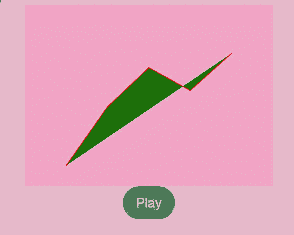harmony 鸿蒙\@AnimatableExtend Decorator: Definition of Animatable Attributes
\@AnimatableExtend Decorator: Definition of Animatable Attributes
The @AnimatableExtend decorator is used to define an attribute method for the non-animatable attribute of a component. During animation execution, a frame-by-frame callback is used to change the value of the non-animatable attribute so that an animation effect can be applied to the attribute. Additionally, you can implement frame-by-frame layout effects by changing the values of animatable properties in the per-frame callback function.
Animatable attribute: If an attribute method is called before the animation attribute, and changing the value of this attribute can make the animation effect specified by the animation attribute take effect, then this attribute is called animatable attribute. For example, height, width, backgroundColor, translate, and fontSize (of the Text component) are all animatable attributes.
Non-animatable attribute: If an attribute method is called before the animation attribute, and changing the value of this attribute cannot make the animation effect specified by the animation attribute take effect, then this attribute is called non-animatable attribute. For example, the points attribute of the Polyline component is a non-animatable attribute.
NOTE
This decorator is supported since API version 10. Updates will be marked with a superscript to indicate their earliest API version.
This decorator can be used in atomic services since API version 11.
Rules of Use
Syntax
@AnimatableExtend(UIComponentName) function functionName(value: typeName) {
.propertyName(value)
}
- \@AnimatableExtend can be defined only globally.
- The parameter of the \@AnimatableExtend decorated function must be of the number type or a custom type that implements the AnimatableArithmetic<T> API.
- In the \@AnimatableExtend decorated function body, only the attribute methods of the component specified in brackets immediately following \@AnimatableExtend can be called.
Available APIs
The AnimatableArithmetic API defines the animation operation rules for non-number data types. To animate non-number data (such as arrays, structs, and colors), implement the addition, subtraction, multiplication, and equality judgment functions in the AnimatableArithmetic<T> API. In this way, the data can be involved in an interpolation operation of the animation and identify whether the data changes, that is, the non-number data is defined as the types that implement the AnimatableArithmetic<T> API. |Name|Input Parameter Type|Return Value Type|Description| |——–|——–|——–|——–| |plus|AnimatableArithmetic<T>|AnimatableArithmetic<T>|Defines the addition rule of the data type.| |subtract|AnimatableArithmetic<T>|AnimatableArithmetic<T>|Defines the subtraction rule of the data type.| |multiply|number|AnimatableArithmetic<T>|Defines the multiplication rule of the data type.| |equals|AnimatableArithmetic<T>|boolean|Defines the equality judgment rule of the data type.|
Example
The following example implements the frame-by-frame layout effects by changing the width of the Text component.
@AnimatableExtend(Text)
function animatableWidth(width: number) {
.width(width)
}
@Entry
@Component
struct AnimatablePropertyExample {
@State textWidth: number = 80;
build() {
Column() {
Text("AnimatableProperty")
.animatableWidth(this.textWidth)
.animation({ duration: 2000, curve: Curve.Ease })
Button("Play")
.onClick(() => {
this.textWidth = this.textWidth == 80 ? 160 : 80;
})
}.width("100%")
.padding(10)
}
}

The following example implements a polyline animation effect.
class Point {
x: number
y: number
constructor(x: number, y: number) {
this.x = x
this.y = y
}
plus(rhs: Point): Point {
return new Point(this.x + rhs.x, this.y + rhs.y)
}
subtract(rhs: Point): Point {
return new Point(this.x - rhs.x, this.y - rhs.y)
}
multiply(scale: number): Point {
return new Point(this.x * scale, this.y * scale)
}
equals(rhs: Point): boolean {
return this.x === rhs.x && this.y === rhs.y
}
}
// PointVector implements the AnimatableArithmetic<T> API.
class PointVector extends Array<Point> implements AnimatableArithmetic<PointVector> {
constructor(value: Array<Point>) {
super();
value.forEach(p => this.push(p))
}
plus(rhs: PointVector): PointVector {
let result = new PointVector([])
const len = Math.min(this.length, rhs.length)
for (let i = 0; i < len; i++) {
result.push((this as Array<Point>)[i].plus((rhs as Array<Point>)[i]))
}
return result
}
subtract(rhs: PointVector): PointVector {
let result = new PointVector([])
const len = Math.min(this.length, rhs.length)
for (let i = 0; i < len; i++) {
result.push((this as Array<Point>)[i].subtract((rhs as Array<Point>)[i]))
}
return result
}
multiply(scale: number): PointVector {
let result = new PointVector([])
for (let i = 0; i < this.length; i++) {
result.push((this as Array<Point>)[i].multiply(scale))
}
return result
}
equals(rhs: PointVector): boolean {
if (this.length != rhs.length) {
return false
}
for (let i = 0; i < this.length; i++) {
if (!(this as Array<Point>)[i].equals((rhs as Array<Point>)[i])) {
return false
}
}
return true
}
get(): Array<Object[]> {
let result: Array<Object[]> = []
this.forEach(p => result.push([p.x, p.y]))
return result
}
}
@AnimatableExtend(Polyline)
function animatablePoints(points: PointVector) {
.points(points.get())
}
@Entry
@Component
struct AnimatablePropertyExample {
@State points: PointVector = new PointVector([
new Point(50, Math.random() * 200),
new Point(100, Math.random() * 200),
new Point(150, Math.random() * 200),
new Point(200, Math.random() * 200),
new Point(250, Math.random() * 200),
])
build() {
Column() {
Polyline()
.animatablePoints(this.points)
.animation({ duration: 1000, curve: Curve.Ease })// Set animation parameters.
.size({ height: 220, width: 300 })
.fill(Color.Green)
.stroke(Color.Red)
.backgroundColor('#eeaacc')
Button("Play")
.onClick(() => {
// points is a data type that implements the animation protocol. During the animation, points can be changed from the previous PointVector data to the new one based on the defined operation rules and animation parameters to generate the PointVector data of each frame and then generate an animation.
this.points = new PointVector([
new Point(50, Math.random() * 200),
new Point(100, Math.random() * 200),
new Point(150, Math.random() * 200),
new Point(200, Math.random() * 200),
new Point(250, Math.random() * 200),
])
})
}.width("100%")
.padding(10)
}
}

你可能感兴趣的鸿蒙文章
harmony 鸿蒙Application State Management Overview
harmony 鸿蒙AppStorage: Storing Application-wide UI State
harmony 鸿蒙Basic Syntax Overview
harmony 鸿蒙\@Builder Decorator: Custom Builder Function
harmony 鸿蒙\@BuilderParam Decorator: Referencing the \@Builder Function
harmony 鸿蒙Creating a Custom Component
harmony 鸿蒙Mixing Use of Custom Components
harmony 鸿蒙Constraints on Access Modifiers of Custom Component Member Variables
- 所属分类: 后端技术
- 本文标签:
热门推荐
-
2、 - 优质文章
-
3、 gate.io
-
7、 openharmony
-
9、 golang